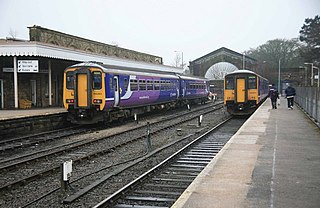
The Bure Valley Railway is a 15 in minimum gauge visitors' attraction in Norfolk, England. It was created on the original disused full-gauge bed of a defunct passenger service to incorporate a new, adjacent pedestrian footpath.

The River Bure is a river in the county of Norfolk, England, most of it in the Broads. The Bure rises near Melton Constable, 11 miles (18 km) upstream of Aylsham, which was the original head of navigation. Nowadays, the head of navigation is 10 miles (16 km) downstream at Coltishall Bridge. After Aylsham Lock and Burgh Bridge, the Bure passes through Buxton Lammas, Coltishall, Belaugh, Wroxham, Horning, past St. Benet's Abbey, through Oby, Acle, Stokesby, along the northern border of the Halvergate Marshes, through Runham and Great Yarmouth where it meets Breydon Water and flows into the sea at Gorleston.
The Bure Valley Path is a 9-mile (14 km) long walking trail and cycling trail in Norfolk, England. It runs alongside the Bure Valley Railway, a heritage railway from Wroxham to Aylsham.

Buxton is a village in the parish of Buxton with Lamas, in the Broadland district of the county of Norfolk, England. It is located between Norwich and Aylsham, and is separated from Lamas by the River Bure. In 2021, it had a population of 1,295.

Chinley railway station serves the rural village of Chinley in Derbyshire, England. The station is 17+1⁄2 miles (28.2 km) south east of Manchester Piccadilly, on the Hope Valley Line from Sheffield to Manchester. It is unstaffed and is managed by Northern Trains.

Buxton railway station serves the Peak District town of Buxton in Derbyshire, England. It is managed and served by Northern Trains. The station is 25+3⁄4 miles (41.4 km) south east of Manchester Piccadilly and is the terminus of the Buxton line.

Dove Holes railway station serves the village of Dove Holes, Derbyshire, England. The station is on the Buxton line between Manchester Piccadilly and Buxton; it is situated 22+3⁄4 miles (36.6 km) south-east of Piccadilly. It is managed and served by Northern Trains.

Furness Vale railway station in Derbyshire, England, is 15+1⁄4 miles (24.5 km) south east of Manchester Piccadilly on the Manchester to Buxton line and serves the village of Furness Vale. It has a level crossing at the end of the platform controlled by a signal box.

New Mills Newtown railway station serves the Peak District town of New Mills in Derbyshire, England. The station is 14+1⁄4 miles (22.9 km) south east of Manchester Piccadilly on the Manchester to Buxton line. It also serves as an interchange with the Hope Valley Line station New Mills Central, 15 minutes' walk away across the valley.

Middlewood railway station serves the village of High Lane in the Metropolitan Borough of Stockport, Greater Manchester, England. It is a stop on the Buxton Line between Manchester Piccadilly, Stockport and Buxton. The station is managed and served by Northern Trains; it is the last station on the line within the Transport for Greater Manchester ticketing area.

Hazel Grove railway station is a junction on both the Stockport to Buxton and Stockport to Sheffield lines, serving the village of Hazel Grove, Greater Manchester, England.

Woodsmoor railway station is on the Buxton Line in Woodsmoor, a suburb of Stockport, Greater Manchester, England. It was opened by British Rail in 1990.

Heaton Chapel railway station serves the Heaton Chapel and Heaton Moor districts of Stockport, Greater Manchester, England. It is 4+1⁄2 miles (7.2 km) south of Manchester Piccadilly towards Stockport. It opened as Heaton Chapel & Heaton Moor in 1852 by the London & North Western Railway. It was renamed Heaton Chapel by British Rail on 6 May 1974.

Levenshulme railway station is in Levenshulme, Manchester, England. The station is 3.1 miles (5 km) south east of Manchester Piccadilly towards Stockport.

Buxton railway station serves the village of Buxton in Norfolk. The station was built as part of the East Norfolk Railway and operated from 1880 to 1952. After closure the trackbed was purchased by Broadland District Council, which led to the construction of a narrow-guage railway, the Bure Valley Railway, which currently serves the station.

Buxton with Lamas is a civil parish in Broadland in the English county of Norfolk. It comprises the villages of Buxton lying to the west of the River Bure and Lamas on the eastern side of the river. At this point the River Bure is crossed by the Bure Valley Railway on a 105-foot (32 m) long girder bridge. Buxton has a halt on the railway. The former railway station on the Great Eastern Railway was called Buxton Lamas prior to closure of the line.

Desborough railway station was built by the Midland Railway on its extension from Leicester to Bedford and Hitchin.

Higher Buxton railway station was opened in 1894 to the south east of Buxton, Derbyshire, on the LNWR line to Ashbourne and the south.
Norbury and Ellaston railway station was on a branch of the North Staffordshire Railway between Rocester and Ashbourne. The station, which had a waiting room, ticket office, and stationmaster's office, and two side platforms, opened at Norbury, Derbyshire in 1852.

Buxton (Midland) railway station served the town of Buxton, Derbyshire, England between 1863 and 1967.


















